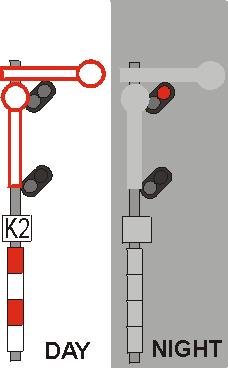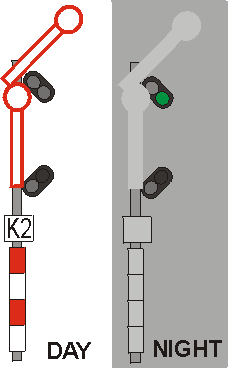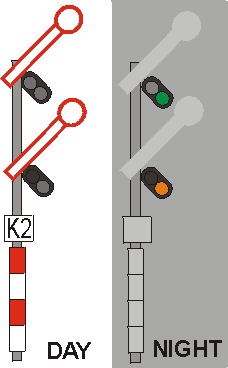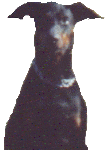A light-based
semaphore (light-signal), which is the most
common used on PKP, consists of the pole (painted in
white and red stripes) and the so-called head, where
several lights are placed vertically. Sometimes the
conditions require one more light - light stripe,
which is put below the head.
Every semaphore has its unique (for every switch
region or simply the station) 'name', written on the
plate below the head. For example, on the picture
there's written: "K2 1/2, m" which should
be translated as follows:
- K2 is the name of
the semaphore. Actually you can spot two ways
of giving the 'names'. The semaphores are
named A, B, C.... without any numbers, or
they have additional numbers telling the one
group from the other or even pointing the
track-numbers, for example: A101, A102,
A103...
- The additional
number after the name (usually the
superscript) indicates the number of lights
that must be reflected so that the semaphore
gives the ride-allowance signal. For example
"1" means that ride-allowance
signal consists always of one light,
"2" - always two lights, and
"1/2" - one or two lights,
depending of the particular situation.
- Letter
"m" below is't obligatory. If
present, the semaphore signals are valid for
shunting, which means no separate shunting
signal is connected with the particular
point.
The lowest number of
lights in one semaphore is two (usually spotted in
'manual block control' semaphore), the maximum is
six, but these six-cell semaphores are (according to
the E1-Rules) valid until their final cancellation.
Just few stations were provided with these 6-cell
semaphores, and the light-combinations reflected on
these semaphores are in some cases a little bit
different from the standard ones.
In some very rare
cases, the semaphore doesn't have a pole, but the
head is just placed on the small base with the
name-plate. Such semaphore is called
'dwarf-semaphore'. Red-white stripes in this case are
painted on the head.
If the semaphore is
cancelled, a white cross is mounted between the
cells, on the head. Such semaphore must be regarded
as non-existed.
A shape-based
semaphore (classic, mechanical) consists of
the pole and one or two arms. The separate plates,
one for white-red stripes, and second one for the
name, are placed on the pole. The arms have red
contour in front and the black one in back. There're
also some lamps coordinated with the movement of the
arms. The upper arm (obligatory presence) can be
raised up to 45 degrees, and the lower arm (optional)
in its base position is vertical, and can be lowered
down to 45 degrees.
Mechanical semaphores
have two interpretations depending of the night or a
daylight. During the day, the signal is given by the
arm(s), and during the night - by the lights mounted
at every arm.
There's no possibility
of reflecting shunting signals on a mechanical
semaphore, so the letter 'm' never is present on the
name-plate.
Mechanical semaphore
never indicates the signal given by the next
semaphore. If such signal is required, the semaphore
must be provided with the forewarning signal. See the
separate section about forewarning signals.
The cancellation of
the shape-based semaphore requires mounting the white
cross on the upper arm, or demounting the upper arm.
SIGNALS
GIVEN BY LIGHT SEMAPHORES
|
 |
S1 'STOP'
no clear route
|
 |
S2 'HIGHBALL'
clear route, proceed with
maximum allowed (indicated for the particular
train in internal timetable) speed
|
 |
S3 'MAX 160, THEN 100, TWO
BLOCKS CLEAR'
clear route, proceed with
speed not exceding 160 km/h;
two next blocks are clear
next semaphore must be passed with no more than
100 km/h
|
 |
S4 'NEXT IS 40 OR 60'
clear route, proceed with
maximum allowed (indicated for the particular
train in internal timetable) speed;
next semaphore indicates speed limit to 40 or 60
km/h
The
semaphore indicates, that after passing the next
semaphore, the train probably will go to a side
track. When you pass through the switch on a side
track you must limit the speed.
|
 |
S5 'NEXT IS STOP'
clear route, proceed with
maximum allowed (indicated for the particular
train in internal timetable) speed;
next semaphore indicates S1 signal - 'stop'
|
 |
S6 'MAX 100, THEN MAX ALLOWED'
clear route, proceed with
speed limited to100 km/h;
after passing all the switches protected by this
semaphore, proceed with maximum allowed
(indicated for the particular train in internal
timetable) speed
Usually
this, or similar semaphore (limiting the speed to
100 km/h) is set before the double-switch
(so-called 'English Switch'), where two track are
crossed with the possibility to pass from the one
to another. Such switches in Poland can be passed
with maximum speed of 100 km/h.
|
 |
S7 'MAX 100, THEN 100'
clear route, proceed with
speed limited to100 km/h;
at the next semaphore proceed with speed limited
to 100 km/h
The
possible situation requiring use such signal is
when the train is to pass the station without
stop, and the station is provided with
English-type (double) switches at both ends.
|
 |
S8 'MAX 100, THEN 40 OR 60'
clear route, proceed with
speed limited to100 km/h;
the next semaphore indicates the speed limited to
40 or 60 km/h
|
 |
S9 'MAX 100, THEN STOP'
clear route, proceed with
speed limited to100 km/h;
next semaphore reflects S1 signal - 'stop'
Entering
the station which is provided with English-type
switches, the train must limit its speed to 100
km/h, even while not passing onto the side-track,
and then the train stops.
|
 |
S10 '40 THAN HIGHBALL'
clear route, proceed with
speed limited to 40 km/h;
the next semaphore indicates S2 signal - maximum
allowed (indicated for the particular train in
internal timetable) speed
Usually
this, or similar semaphores (limiting the speed
to 40 km/h) is set when the train must pass to a
side track on a switch. Classically, the switches
in Poland let pass the train to a side-track with
maximum speed limited to 40 km/h, sometimes 60
km/h (not often), sometimes 100 km/h (very rare).
|
 |
S10a 'MAX 60, THEN HIGHBALL'
clear route, proceed with
speed limited to 60 km/h;
the next semaphore indicates S2 signal - maximum
allowed (indicated for the particular train in
internal timetable) speed
|
 |
S11 'MAX 40, THEN MAX 100'
clear route, proceed with
speed limited to 40 km/h;
the next semaphore indicates speed limited to 100
km/h
We can
imagine the situation requiring use such signal.
The train must go to a side track (for example at
the junction) on a classic old-type switch. After
passing it the train could accelerate to maximum
allowed speed, but at the end of the station
there's a passing using English-type switches
(double switch) which can't be passed with more
than 100 km/h.
|
 |
S11a 'MAX 60, THEN MAX 100'
clear route, proceed with
speed limited to 60 km/h;
the next semaphore indicates speed limited to 100
km/h
|
 |
S12 'MAX 40, THEN 40 OR 60'
clear route, proceed with
speed limited to 40 km/h;
the next semaphore indicates speed limited to 40
or 60 km/h
|
 |
S12a 'MAX 60, THEN 40 OR 60'
clear route, proceed with
speed limited to 60 km/h;
the next semaphore indicates speed limited to 40
or 60 km/h
|
 |
S13 'MAX 40, THEN STOP'
clear route, proceed with
speed limited to 40 km/h;
the next semaphore indicates S1 signal - 'stop'
Standard
situation concerning the train entering the
station. The train must go on a side track, so 40
is required while passing the switch. Then, the
train must simply stop at the platform.
|
 |
S13a 'MAX 60, THEN STOP'
clear route, proceed with
speed limited to 60 km/h;
the next semaphore indicates S1 signal - 'stop'
|
 |
[...] /valid
until cancellation/ 'SPEED LIMIT'
or:
'SPEED LIMIT, THAN CLEAR
ROUTE'
speed limit or speed limit
with the next semaphore reflecting ride allowance
signal
|
 |
[...] /valid
until cancellation/ 'CLEAR ROUTE THAN SPEED
LIMIT'
ride allowance signal, the
next semaphore reflecting limited speed
|
SIGNALS
GIVEN BY MECHANICAL (SHAPE-BASED) SEMAPHORES
|
 |
Sr1 'STOP'
no clear route
|
 |
Sr2 'HIGHBALL'
clear route, proceed with
maximum allowed speed indicated for the
particular train at the internal train-timetable
|
 |
Sr3 '40 THAN HIGHBALL'
clear route, proceed with
speed limited to 40 km/h;
after passing the last switch protected by this
semaphore, proceed with maximum allowed speed
indicated for the particular train at the
internal train-timetable
|
|
|



